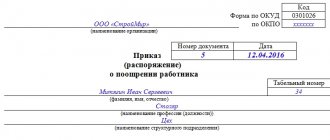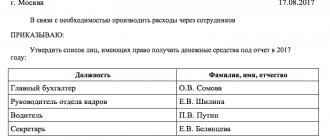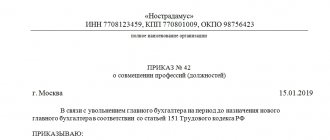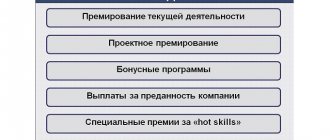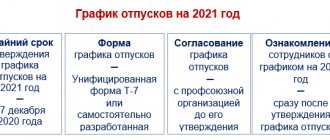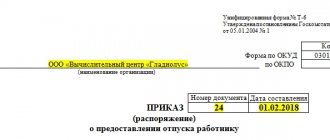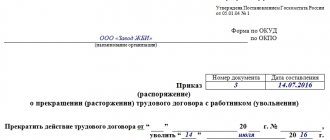The management of most large enterprises, budgetary organizations and government agencies practice the use of a system of material incentives for workers and employees. In this case, wages consist of salary, allowances and bonuses established in accordance with current legislation. In order to legalize the use of the enterprise's funds for its intended purpose, an order is issued to award bonuses to employees. A few words about the nuances of its preparation.
Types of employee incentives
It is allowed to encourage an employee not only in material form. The main types of incentives used in practice:
- announcement of gratitude;
- cash bonus;
- nomination for the title of the best in the profession;
- issuance of a valuable gift;
- awarding a certificate of honor.
The list, in accordance with Art. 191 of the Labor Code of the Russian Federation is not closed; the bonus system is established for each specific enterprise in local regulations. For special achievements, a presentation for state awards may follow.
How to correctly formulate justification in an order?
The most important thing is to use clear, specific and non-vague formulations (read about the grounds for remunerating an employee and how to formulate them correctly, and from this article you will learn how to create a competent formulation of bonuses for full-time trade union workers).
Examples:
- For years of service in the company, that is, for many years of conscientious and continuous work.
- For carrying out additional workload, for performing, in addition to the main, secondary duties.
- For the implementation and implementation of various events and activities that had a beneficial effect on the work environment.
- For high production performance. For example, a worker, instead of 20 units of goods, sold as many as 35.
What documents are required to document the bonus?
The announcement of the payment of a bonus to an employee is made by an administrative document for the enterprise, an order is issued to reward the employee for conscientious work, achievements in work, fulfillment of the plan, etc.
It has several varieties:
- mass - imposed on an entire group of workers, the majority of the team;
- personal - issued in relation to a specific employee;
- scheduled - published at a certain frequency;
- unscheduled - published in connection with the occurrence of a specific event, outside the established periodicity;
- production - taken in connection with achieving results in production;
- organizational - published in gratitude for active participation in the public life of the enterprise, for example, for achievements at sporting events;
- festive - in connection with the onset of memorable dates, holidays, anniversaries.
Taxation of premiums
Since a bonus is a type of salary, i.e. in fact, this is part of it, then it also belongs to the tax base, like the salary itself. Those. As a general rule, personal income tax and insurance premiums are withheld from the premium amount . Exceptions include the following cases:
- Foreign or domestic awards for achievements in science, education, literature, art, technology (inventions, Nobel Prize, UNESCO Prize, etc.).
- Payments as financial assistance, which can be paid no more than 4,000 rubles per year for each employee. Accordingly, taxes and contributions are paid on all excess amounts.
And finally, video instructions for drawing up a document, as well as an analysis of the possible consequences in case of its absence.
Memo about bonuses
The basis for issuing an administrative act on bonuses is a memo, presentation or petition from the employee’s immediate supervisor or the head of another service or department. This document must indicate the employee’s achievements or other grounds for bonuses. The payment amount is indicated by a specific figure or an indication of the percentage of the salary, etc. The head of the enterprise has the right to decide to increase or decrease the monetary reward.
ConsultantPlus experts discussed how to process and take into account bonuses for employees. Use these instructions for free.
Employee bonuses: 6 risks for the employer
Since issuing a bonus is a financial transaction, there are certain risks on the part of the inspection inspectors. They concern, first of all, tax inspectors, but often come from representatives of the labor inspectorate.
Risk 1. Incorrect wording in the employment contract
Often, an employer indicates that its employee with whom the contract is concluded is entitled to a monthly or quarterly bonus in a set amount, for example 15% of his salary. In this case, the bonus in fact becomes an integral part of the salary, since the employer pays it within the agreed terms and in the established amounts, the obligations of which he himself has assumed. It is more correct to reflect the fact of payment in the category of “right” rather than “obligation” of the employer - otherwise, in essence, it is no longer a bonus, but a salary.
Risk 2. Payments of “13 salaries”
A bonus at the end of the year in the amount of the entire average salary or a significant part of it is traditionally called the “13th salary.” There is no such concept in the law; accordingly, such a bonus is the exclusive goodwill of the employer. But again, it is important to correctly reflect it in the employment contract (individual and collective), as well as in the local internal acts of the enterprise. At the same time, only references to these acts can be indicated in contracts, and the payment procedure must be spelled out in as much detail as possible in the acts:
- connection between salary payment and employee performance indicators;
- the possibility of non-payment of this type of premium with a detailed description of the entire list of reasons, including due to an economically unfavorable situation;
- It is especially important to pay attention to the procedure for payment upon dismissal: should the employee work the whole year or not, how to pay if the dismissal occurs due to layoffs, liquidation of the company, etc.
Risk 3. Holiday bonuses
Such payments are considered by most managers as symbolic gifts in the amount of 500-1000 rubles. Therefore, attention is often not paid to this point, and everything comes down to the wording “The employer pays each employee a bonus of 1000 rubles annually by March 22 – the company’s Founding Day.” In this case, it is better to protect yourself from financial risks and indicate that the company undertakes to do this only if possible, and also reserves the right not to pay a bonus if the employee grossly violated the work schedule, etc.
Risk 4. Bonus amount and working hours
One should also take into account the important point that not all employees work the standard/quarterly/monthly hours due to various circumstances - vacations at their own expense, sick leave, maternity or child care leave, etc. Therefore, the amount of the bonus, as well as the very possibility of its payment, should be closely and unambiguously linked to a certain norm: for example, at least 180 working days.
Risk 5. Deduction of bonuses and deprivation of the right to a bonus
These concepts are widely present in real labor practice, however, confusion often arises with the interpretation both in documents and at the level of oral explanation by management of company standards for employees. In an employment contract, collective agreement and other documents, it is important to clearly distinguish both concepts. If deprivation of bonuses is a measure that is legally taken by the employer in the event of a significant mistake made by an employee while performing his duties, then deprivation of the right to a bonus may also have purely economic, objective reasons. Usually all these nuances are spelled out in detail in local acts.
Risk 6. How to properly develop premium reduction mechanisms
Both the grounds for accrual/non-accrual of the premium and the grounds for its justified reduction should be specified in the local act in great detail. It is best to give not specific numbers (a reduction of 500 rubles, etc.), but percentages - for example, “if an error is made when servicing a client, which leads to his refusal to cooperate, the monthly premium is reduced by 10% from the initially established amounts." Most often, the size of the reduction is set using a simple formula - proportional to the extent to which the plan was fulfilled, and it is important to take into account not only individual indicators, but also the connection with the performance indicators of the department and the entire unit. This is especially true for large companies.
Thus, it is better to foresee all the key points given in advance. The main criterion for the correct procedure for awarding bonuses to an employee is drawing up orders and contracts in such a way that he himself can calculate the amount of payment at any time. Those. The calculation of the premium must be extremely transparent, and the grounds for payment or non-payment must be extremely clear.
Orders in form T-11 and T-11a
The administrative document is drawn up according to the standard form T-11, approved by the State Statistics Committee (but is not currently mandatory for use), or in free form. The organization has the right to develop its own sample.
Form T-11 is used if one employee needs to receive a bonus.
If several employees are worthy of a bonus, the T-11a form is used.
Document structure:
- a header containing the details of the organization and the document (name of the enterprise, number, date of issue of the order, its subject);
- the main part with written documentation of the employer’s order and its basis;
- final (signatures, their transcripts, there must be a note about the employee’s familiarization).
The main part must indicate:
- who exactly is being rewarded (full last name, first name and patronymic, personnel number, department and position held);
- what the bonus is for: the wording of the basis for the bonus in the order is of great importance, since the employee has the right to know why he receives the bonus. The wording used is an indication of specific achievements and merits. For example, phrases are often used: “in connection with the anniversary”, “for production successes”, “for professionalism and processing”, etc.;
- the amount of remuneration or the procedure for determining it;
- the period for which the allowance is made.
Sample order to reward employees for good work
| LLC "Ppt.ru" city of St. Petersburg Order No. 11 about one-time bonus "10" December 2021 Based on the memo of the deputy director dated 12/08/2020, presentation, bonus regulations I ORDER: 1. For fulfilling the plan, good work, achieving high performance indicators, pay a one-time cash bonus in the amount of 10,000 (Ten thousand) rubles to lawyer Ivan Ivanovich Ivanov. 2. I entrust control over the implementation of this Order to myself. General Director P. P. Petrov |
Results
The order for a bonus, a sample of which is discussed in our article, can be drawn up either in any form or using the unified form T-11. The main thing is that it contains all the necessary details: the name of the employer, the number and subject of the order, the date of its preparation, the main section (containing an indication of the reason for the bonus, data of the employees receiving the bonus and the amount of the bonus due to them), as well as the signatures of the manager and those familiar with the order workers.
Sources: Labor Code of the Russian Federation
You can find more complete information on the topic in ConsultantPlus. Free trial access to the system for 2 days.
Order on monthly bonuses
Sometimes an employer, when determining the form of remuneration at an enterprise, opts for a salary-bonus system. In this case, an administrative document is issued, which sets out the conditions for payment of bonuses. To determine the grounds and procedure for bonuses, the employer has the right to adopt a separate local regulation. The regulations on bonuses define the grounds: memo, report, data on the implementation of the plan, describe the publication of an administrative act and other nuances, right down to the wording of how to write: to reward an employee with a cash bonus or pay bonuses, etc.
The essence and types of the document
The specifics of the bonus are determined by 2 points:
- This is a voluntary act of the employer, i.e. This is his right, not his duty. As a rule, the employment contract stipulates that the company can provide bonuses to the employee, which in practice implies only one possible case - the initiative of the employer.
- On the other hand, there are no uniform rules for calculating bonuses: i.e. The legislation does not provide for the mode, amount and specifics of payment (on the day of salary or advance payment).
Thus, as for the very fact of paying the bonus, the procedure for this procedure, all this is the good will of the company, and specifically of the authorized persons who have the right to make the appropriate decision. Therefore, responsibility arises only for the correct execution of this financial transaction in the documentation. Exceptions are those cases when the employment contract initially specified the amount of the bonus and the procedure for paying it to the employee.
NOTE. According to labor law, the bonus is a component of the salary. Accordingly, it can only be issued on those days specified in the employment contract.
The procedure for drawing up an order largely depends on the size of the enterprise and the number of its staff: if bonuses for employees in a small company can be organized literally in 1 day, then in a large division the procedure is much more complicated. In general, the order is as follows:
- All heads of branches and separate divisions are notified of the need to prepare for bonuses and, in response, draw up initial lists of employees indicating the position, full name and grounds for the possible accrual of bonuses.
- According to the declared employees, authorized persons are studying the possibility of bonuses in each specific case in accordance with the internal regulations of the companies (fulfillment of the plan, performance indicators, etc.).
- Based on this analysis, the list is adjusted or left unchanged and distributed to all departments.
- The final version is transferred to the draft order, after which the finally approved document on bonuses for employees is printed.
- Each employee included in the list familiarizes himself with the document and must sign.
If some types of bonuses are awarded annually, quarterly and even monthly, others may be allocated on an extraordinary basis. Therefore, the classification of orders depends specifically on the order in which bonuses are issued:
- mass and isolated cases – i.e. immediately to the entire team (or department) or individual colleagues for individual successes;
- planned (periodic) and unscheduled (irregular) - depending on the financial capabilities of the company, bonuses can be issued constantly or only in individual cases.
These payments are classified depending on the reason for the premium:
- Holidays – this often includes corporate gifts in the form of additional payments for the New Year, March 8, as well as a professional holiday.
- Production – i.e. for services related to the implementation of the plan, the implementation of effective measures that improve the work process, optimize production, help save resources, etc.
- Organizational in nature – i.e. awards for successful preparation and implementation of certain events in the interests of the company. For example, a seminar, a round table on an issue, a meeting of clients or guests from abroad, organizing a corporate event, etc.
NOTE. The bonus can be awarded not only in connection with labor successes, but also in connection with holidays, i.e. the employer himself has the right to choose the basis. However, such payments are not intended to help an employee in a difficult life situation. Then we are talking about providing financial assistance. Therefore, most often a bonus is understood as an additional payment exclusively for labor achievements, which, at the same time, can be timed to coincide with holidays.
Sample texts
For calendar holidays
To the director of the restaurant "Prestige" in Murmansk
Myasoedov Peter Alexandrovich
Krivorukov Sergei Petrovich
Internal memo regarding the award of a bonus to the chief chef Nadezhda Georgievna Karavaeva for International Women's Day on March 8th.
During 2010 - 2021 Karavaeva N.G. is the leading chef of our restaurant. She successfully coordinates the work of the kitchen, independently develops recipes for new dishes that attract customers to our establishment.
Nadezhda Georgievna creates and supplements the menu, monitors and controls costs for products and inventory, and works on marketing initiatives. The chef cooks herself for large celebrations and special events.
Thanks to her work, from January to March 2021 the number of regular visitors increased by 15%. There have been no complaints about the restaurant's work during this time.
Senior manager (signature) Krivorukov S.P.
In connection with the anniversary
Head of the education department of the Petrovsky district
No. 148 Petrishcheva Larisa Vasilievna
Directors of secondary school No. 21
Lisitsyna Valentina Maksimovna
An official note on the bonus given to the Russian language teacher Eduard Germanovich Potemkin in connection with his 50th anniversary.
Potemkin E.G. has been working at school No. 21 as a teacher of Russian language and literature for 25 years.
This is an honored teacher with the highest category. Eduard Germanovich's students show excellent knowledge, the teacher is respected by parents and colleagues.
The teacher shows creative initiative in preparing school-wide events, is the leader of the “Living Word” circle, and has been repeatedly awarded certificates of honor for his success in educating the younger generation.
School director (signature) Lisitsyna V.G.
How to write correctly?
An internal memo is a form of internal document management that allows you to quickly resolve current production situations. The purpose of writing this business paper is to notify any official about an existing problem, make proposals for resolving it or agreeing on planned actions.
When preparing memos about the bonus and its deprivation, adhere to the general recommendations for writing such documents of internal business correspondence.
The structure of the memos is:
- Indication of the addressee (the last name, first name, patronymic, as well as the position of the person to whom the appeal is sent is written in the upper right corner of the official paper).
- Indication of the last name, first name, patronymic and position of the document originator.
- The name of the document and its number with the date of preparation.
- Statement of the essence of the issue.
- Suggestions or indications of expected actions on the part of the addressee.
- Signature of the constituent person with its decoding (surname, initials and position).
In addition, it is better to pass the note through a secretary or send it by registered mail so that the incoming document is properly registered.
Depending on the direction, notes can be of various types:
- complaint;
- conclusion;
- request.
When writing memos regarding financial rewards, the following are used:
- A memo-conclusion - for rewarding an employee indicating, for example, the number of tasks completed above the norm for which he can be rewarded, which is what the manager requests.
- A memo-request is used to ask for some action, in our case, for a bonus for yourself for an excellent job or completing a large volume of tasks.
- A memo-complaint to justify the deprivation of bonus payments to an employee.
uniform requirements for internal memos approved by law , so the company has the right to develop templates that are convenient for filling it out, or allow a free form of presentation, taking into account the business information style. Below you can find examples and samples of memos.
The importance of the document when promoting
An employee bonus is an excellent motivational tool to influence the work efforts of employees. By skillfully using it, a manager can masterfully manage the mood of employees, increasing the efficiency of the organization.
But if the size and procedure for paying official salary are fixed, then the issues of bonuses or deprivation of bonuses remain at the discretion of the employer.
It must be taken into account that all employees are entitled to a bonus , regardless of whether they actually bring profit to the company. For example, often accounting workers who award bonuses to other employees themselves remain “overboard” from bonus payments, although the correct maintenance of the company’s documentation depends on their work.
However, a competent manager must take into account that before submitting reports, the workload increases many times over, emergency situations often occur, and any reports submitted late are subject to penalties. During such periods, additional duties are added to the usual ones:
- filling out reports and sending them;
- collecting the necessary information.
Often, accounting employees are forced to make changes to the documentation and additionally advise managers regarding the correctness of completion. Therefore, their bonuses can serve as good compensation for the efforts expended .
To avoid claims and litigation regarding bonus payments, reasoned documentary justification is required. Direct evidence in such cases can be a correctly drafted memo.
An additional benefit of writing bonus memos is that they are direct evidence that the specialist has covered an issue within his area of expertise. If a specialist does not have the authority to independently make a decision on issues of financing employees, he, in the form of an internal memo, submits this issue for resolution by other specialists, thereby relieving himself of responsibility for the timeliness of payments, as well as a positive or negative response to the petition.
Are insurance premiums paid?
Taxes are paid on a one-time bonus only if it is properly processed. Insurance premiums are transferred by the employer from this amount, regardless of whether it is included in expenses when calculating income tax. Therefore, the employer will not be able to save on these contributions.
If a citizen works in a joint-stock company, then the founders have the right to transfer funds from retained earnings. In this case, they will have to hold a shareholders meeting and also formally make a decision. This method of transferring bonuses does not reduce the company's taxable profit.
Deadline for payment of annual bonus
The very fact of paying the bonus at the end of the year before its end contradicts the essence of this payment. This is due to the fact that the bonus is paid precisely “based on the results of the past year.” This means that in order to pay such a bonus, the organization must summarize the work for the year. Of course, this can be done no earlier than December 31st.
When paying an annual bonus before the end of the calendar year, an organization may face a number of significant problems. For example, if bonuses are calculated in proportion to the time worked in a year. In this case, if an employee gets sick or goes on vacation (cannot perform duties for another reason), the bonus accrued to him will have to be recalculated. The amount of overpaid bonuses will need to be withheld from the employee. But the organization cannot do this on its own initiative (Article 137 of the Labor Code of the Russian Federation).
As a result, we advise you to refrain from paying the annual bonus until the end of the year. That is, you will not have any problems if you pay a bonus based on the results of your work for the year on December 31 of the current year or later.
However, from the point of view of the Labor Code of the Russian Federation, there are no violations in early payment. Therefore, if you want to pay the annual bonus ahead of schedule, pay it. But, at the same time, take into account the risks mentioned above.
How to write a service letter
A sample application for bonuses for employees must contain the following information:
- to whom it is addressed: Full name and the position of manager;
- from whom: Full name and the position of the compiler of the memo - the immediate superior of the citizen nominated for the award;
- FULL NAME. and the position of the employee to whom the bonus must be issued;
- justification - a list of merits that give the employee the opportunity to receive additional encouragement for his work;
- proposed bonus amount;
- date of compilation and signature.
When are employees given bonuses?
The issue of additional remuneration is entirely within the responsibility of the employer. He himself decides when and for what merits to reward employees. The following reasons for bonuses are common:
- special labor merits of a citizen;
- all-Russian and professional holidays;
- individual holidays and special dates of the employee, for example, anniversary, retirement, anniversary of service in the organization.
Labor merits include:
| Increased output | Increasing the number of output units produced over a certain amount of time |
| Improving quality | Reducing the number of defects, returns from consumers, increasing the quality of services provided |
| Economical | Reducing costs, both monetary and time or human, for the production of one unit of output |
| Rationalization | The employee makes proactive proposals to optimize the labor process and organize production |
Why do you need a service letter for a bonus?
The immediate supervisor of a successful employee draws up a sample memo to encourage the employee and sends it to the head of the organization. The document states:
- what needs to be rewarded;
- for what reasons.
That is, the employee’s immediate supervisor sets out in a memo for what merits the employee should be rewarded for. There is no need for a memo about the bonus if the payment of material remuneration in addition to the salary is established by the internal acts of the organization or the employee’s employment contract.
Other important nuances
Before charging a one-time bonus, the employer must take into account some significant features. These include:
- if a bonus is paid upon dismissal of an employee, then personal income tax is charged on it under general conditions;
- if funds are transferred for holidays or other significant events, then they are not related to the professional activities of employees, therefore such expenses cannot reduce the tax base for corporate income tax;
- Unified agricultural tax is not withheld from such remuneration.
Employers can pay one-time remunerations using different taxation systems. It is important to consider whether these payments reduce the tax base.
